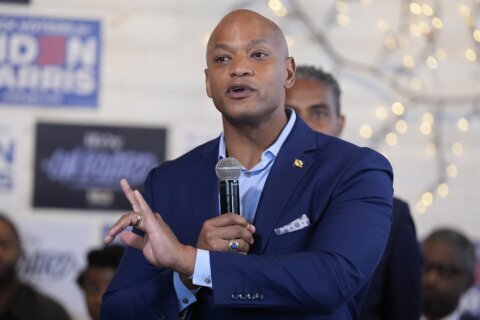This article was republished with permission from WTOP’s news partners at Maryland Matters. Sign up for Maryland Matters’ free email subscription today.
This content was republished with permission from WTOP’s news partners at Maryland Matters. Sign up for Maryland Matters’ free email subscription today.
While Maryland residents and elected officials scurried around in preparation for the holidays last week, the state Department of Transportation quietly took a major step in its $11 billion I-495/I-270 “managed lanes” highway project.
With no notice to the public, the agency issued its formal Request for Proposals (RFP) for the project late on Friday, Dec. 18. The four giant transportation consortiums that have formed to bid on the massive project were given three business days to return the “technical” portion of their responses. (Financial responses are due on Jan. 8.)
MDOT then slipped the RFP onto its website in the early evening hours of Dec. 23, after employees had gone home for the long holiday weekend.
Opponents of Gov. Lawrence J. Hogan Jr.’s plan to rebuild the American Legion Bridge and add “express toll lanes” to the two highways harshly criticized the agency’s efforts to minimize public scrutiny of the RFP.
“I’m not sure even Pete Rahn was arrogant enough to issue an RFP on Christmas Eve and set a deadline for responses before New Year’s Day,” said transit advocate Gary V. Hodge, referring to Hogan’s hard-charging former transportation secretary.
A transportation consultant and leading critic of the state’s plan, Hodge accused MDOT of “flying under the radar with no oversight, accountability, or obligation to respond to the 3,000 citizens, elected officials and public agencies who commented on the Draft Environmental Impact Statement.”
Montgomery County Executive Marc B. Elrich (D) called the quick turnaround “absurd.”
“Nobody could do this project in that length of time,” he added. “That’s just not how you do things.”
Del. Marc Korman (D-Montgomery), the chairman of a key House appropriations subcommittee, noted on Twitter that the RFP was “quietly released to bidders” without a courtesy heads-up to him, even though he had inquired about the document the day before.
“If this is the transparency they provide to me, a legislator w/ oversight of their budget, how transparent do we think they are w/ members of the public and other stakeholders?” he asked on Twitter.
Despite MDOT’s holiday-week release of the RFP and the lightning-quick turnaround, the agency called it “another important milestone” in Hogan’s push for “transformative traffic relief.”
A transportation industry executive said publicly-traded firms — those accountable to shareholders — may find the cloak-and-dagger timing of the RFP “off-putting.”
“Holy s—, that’s ridiculous,” said the executive, who has longstanding ties to large transportation firms and spoke only on condition of anonymity. “That is definitely cynical.”
The RFP’s instructions, the proposed agreement and various exhibits (many of them technically dense and written in legalese) are nearly 1,100 pages in length.
In an interview, project manager Lisa B. Choplin defended the shortened timeline, noting that MDOT has been in close consultation with each of the four firms vying for the project. They received a draft RFP on July 24, giving them five months to prepare their bids.
“This is a very collaborative process,” said Choplin. “We’ve been working collaboratively with those teams in the development of the final RFP.”
“Setting forth the expectations that the state has on the phase developer [the winning bidder] is all laid out in that RFP document,” she added.
Choplin refused to say how many of the four consortiums deemed qualified to handle the project actually submitted a bid.
Hodge, a former chairman of the Tri-County Commission in Southern Maryland, accused MDOT of attempting to push the highway-widening plan “past the point of no return before the governor leaves office.” Hogan is term-limited and will leave office early in 2023.
Project undergoes significant revision
In its RFP, the state discloses for the first time a significant change in how the project will advance.
Under what the agency is now calling “Phase 1 South A,” the state will first build the new bridge, in coordination with Virginia, and add four lanes to the western portion of the Capital Beltway — the stretch that runs from the new span to the western I-270 spur and along the inner loop of I-495 to Old Georgetown Road.
The state’s new “Phase 1 South B” would result in the widening of I-270 between Interstate 370 and the Beltway.
“That actually makes sense,” according to the industry executive.
As for the other pieces of the ambitious plan Hogan unveiled in 2017 — to widen all of I-270, all of I-495 and the federally-owned Baltimore-Washington Parkway — they may not be sufficiently lucrative or environmentally sound enough to lure any bidders, particularly with the rise in telework.
“There would be unpriceable risk,” the transportation industry executive said.
The state’s newly-disclosed configuration is in line with what Elrich has long advocated. He has pushed Hogan for two years to “start at the bridge” and work north and east.
“It’s exactly what I said to do two Decembers ago,” Elrich said. “You start at the chokepoint at the American Legion Bridge and then everything else starts to unwind once you get that done.”
Montgomery County Planning Board Chairman Casey Anderson said the state’s decision to further subdivide the project was not a surprise.
“This project is enormous,” he said. “I had assumed the project might be broken down into smaller chunks to make it more manageable financially, technically, and perhaps politically.”
The construction of variably-priced toll lanes on I-270 between I-370 and Frederick have been re-designated “Phase 1 North,” but that project is subject to a separate two-year environmental review that won’t begin until 2021 at the earliest. A decision on whether to move forward with that segment will likely not occur until Hogan is out of office.
The widening of the Beltway between the I-270 spur and Maryland Route 5 in Prince George’s County is described by the state as a “future phase.” Noting that the incoming Biden administration is likely to take a much tougher line on environmental matters than President Trump, the industry executive dubbed that segment “Project Never.”
Whatever MDOT comes up with, it must be approved by the Board of Public Works, a three-person panel on which Hogan sits.
Aware that Comptroller Peter V.R. Franchot (D) is his most likely shot at the second vote he needs, Hogan may have signed off on a re-phasing of his plan with an eye toward winning the support of the state’s chief tax collector, observers said.
Franchot forced changes to the plan prior to a key vote in July 2019 — and he said in a recent interview he is open to plan to brings congestion relief to the capital region.
A Franchot aide said the comptroller has not been briefed on MDOT’s changes.
In its RFP, MDOT said the winning bid will satisfy a range of goals: “Congestion Relief, Minimize Impacts, No Net Cost to the State, Accelerated Delivery and Shockingly Innovative.”
Critics fume over winning bidder’s early deadlines
Critics of the state’s plans said they are alarmed that the winning bidder is mandated to begin work on the project before MDOT decides which of several lane-design options it will pursue, a process known formally as the “record of decision (ROD).”
The state received 3,000 comments from the public during the four-month feedback period mandated by federal law — and MDOT and its federal partners, the Federal Highway Administration, must respond to each one. Choplin said the volume of responses has caused the agency to re-evaluate the project’s timeline.
But the RFP lays out numerous deliverables (including an initial financing plan) that the winning bidder, slated to be chosen on Feb. 1, will be accountable for within a period of weeks. The ROD isn’t expected to begin until “spring,” according to the agency.
“It’s black and white that work can commence before the record of decision,” said Ben Ross, chairman of the Maryland Transit Opportunities Coalition and a leading critic of the state’s plan. The state’s schedule is proof “that the process is biased,” he said.
“It shows that the [Environmental Impact Statement] process is a facade,” he added. “They haven’t yet considered the 3,000 public comments they got — many of which are very serious and detailed — and they’re locking in the decision…”
Responding to the public’s comments must be done with care if the agency hopes to avoid the types of lawsuits that ended up causing serious delays for the Purple Line, the light rail project under construction linking New Carrollton and Bethesda. Environmental groups have already partnered with high-powered law firms in anticipation of a potential challenge to the highway expansion plans.
In an interview, MDOT phase manager Bryan Kendro said that the “progressive” public-private partnership (P3) approach that the state is using differs from the traditional fixed-price contracts that the public is accustomed to.
“The idea in this project is to bring the developer on board as the state continues to develop it,” he said.
The early engagement moves up the timeline for the winning bidder to provide “a committed section proposal,” with firm price and schedule commitment, Kendro said, “similar to what they would do on a normal P3 project.”
During the period between the firm’s selection and the final record of decision, “they’re working hand-in-glove with MDOT and the state, [and] to work with stakeholders, to work with the utility companies, to work on design, minimizing impacts on right-of-way.”
“They’re not doing any construction work,” Kendro added. “This is really about project readiness.”
The preliminary work allowed under the contract may not involve construction, but it could end up costing taxpayers a sizeable sum.







